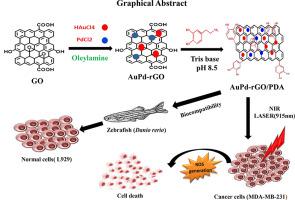Journal of Photochemistry and Photobiology B: Biology ( IF 3.9 ) Pub Date : 2020-09-18 , DOI: 10.1016/j.jphotobiol.2020.112028 Punamshree Das , Sushma V. Mudigunda , Gitashree Darabdhara , Purna K. Boruah , Sachin Ghar , Aravind K. Rengan , Manash R. Das

|
Graphene, which is a unique 2D nanomaterials has received widespread attention for photothermal therapy (PTT) application. Here, we have designed the nanocomposite using polydopamine (PDA) functionalized reduced graphene oxide (rGO) nanosheets and bimetallic AuPd nanoparticles (NPs). The bimetallic AuPd nanoparticles decorated PDA functionalized rGO (AuPd-rGO/PDA) nanocomposite is synthesized by simple chemical reduction technique resulting in an average size of AuPd bimetallic nanostructure of 4.18 nm. The photothermal activity of the AuPd-rGO/PDA nanocomposite is explored under the irradiation of near infrared (NIR) laser sources of wavelength 915 nm. The temperature rises nearly 51 ± 3 °C within 3 min of irradiation NIR laser light resulting in the ablation of MDAMB-231 cancer cells up to concentration of 25 μg mL−1 of AuPd-rGO/PDA nanocomposite. This high performance of the ablation of cancer cells by photothermal therapy technique was facilitated using a low concentration of the nanocomposite by the synergistic effects of the bimetallic AuPd as well as rGO and PDA functionalization. The AuPd-rGO/PDA nanocomposite demonstrated the high biocompatibility towards normal healthy cell lines (L929) and exhibits survival efficiency of more than 85%. We also demonstrated the biocompatibility of the AuPd-rGO/PDA nanocomposite materials on the zebrafish embryos (Danio rerio). This work thus illustrates that the AuPd-rGO/PDA nanocomposite could behave as favourable nanoplatform for tumor therapeutics.
中文翻译:

生物相容性功能化AuPd双金属纳米粒子修饰在氧化石墨烯片上,用于靶向癌细胞的光热治疗
石墨烯是一种独特的2D纳米材料,在光热疗法(PTT)应用中受到了广泛的关注。在这里,我们使用聚多巴胺(PDA)功能化的还原氧化石墨烯(rGO)纳米片和双金属AuPd纳米粒子(NPs)设计了纳米复合材料。通过简单的化学还原技术合成了双金属AuPd纳米粒子装饰的PDA功能化rGO(AuPd-rGO / PDA)纳米复合材料,平均AuPd双金属纳米结构的尺寸为4.18 nm。在波长为915 nm的近红外(NIR)激光源的照射下探索AuPd-rGO / PDA纳米复合材料的光热活性。在照射NIR激光后3分钟内温度升高近51±3°C,导致MDAMB-231癌细胞被消融,直至浓度达到25μgmL -1AuPd-rGO / PDA纳米复合材料的制造。通过使用低浓度的纳米复合材料,通过双金属AuPd的协同作用以及rGO和PDA功能化,促进了通过光热疗法技术实现的癌细胞消融的高性能。AuPd-rGO / PDA纳米复合材料表现出对正常健康细胞系(L929)的高生物相容性,并具有超过85%的存活率。我们还证明了AuPd-rGO / PDA纳米复合材料在斑马鱼胚胎(Danio rerio)上的生物相容性。因此,这项工作说明了AuPd-rGO / PDA纳米复合材料可以作为肿瘤治疗剂的有利纳米平台。











































 京公网安备 11010802027423号
京公网安备 11010802027423号